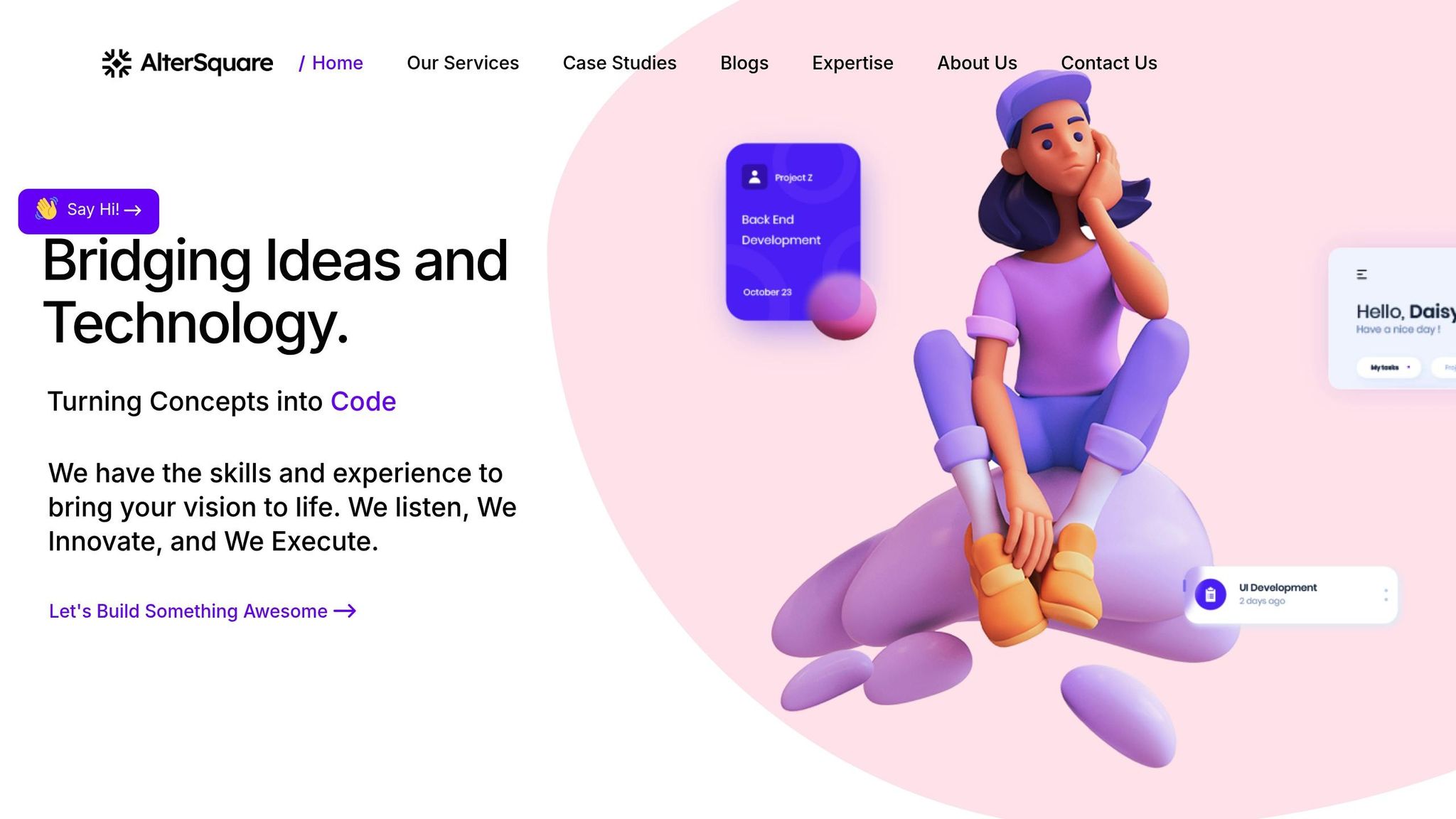Outsourcing in 2025 is no longer about cutting costs at the expense of quality or control. Instead, it’s a tool for startups to grow faster, access expert talent, and improve results. Here’s why the old problems are gone and what has taken their place:
- Old Problems Solved: Issues like poor communication, hidden costs, and quality concerns have been addressed with tools like Slack, Agile workflows, and transparent pricing models.
- What Replaced Them: Outsourcing now focuses on long-term partnerships, real-time collaboration, and shared success. Teams work as extensions of your company, not separate vendors.
- Why It Works Now: Advanced collaboration tools, cloud-based infrastructure, and AI-driven processes ensure smooth integration, better results, and faster project delivery.
Outsourcing has shifted from being risky and frustrating to becoming a reliable way for startups to scale and innovate. It’s all about finding the right partner who aligns with your goals and delivers measurable outcomes.
Scaling Smart: Unlocking Startup Growth with Outsourcing
Why Old Outsourcing Problems No Longer Exist
The outsourcing world of 2025 looks nothing like the industry of the past. Many of the challenges businesses once faced have been resolved through advancements in technology and higher industry standards. What used to be a source of frustration has now evolved into a streamlined, efficient process.
Past Problems: Control Loss, Quality Issues, and Hidden Costs
Outsourcing used to come with a host of challenges, leaving many businesses hesitant to embrace it fully. These included communication difficulties, mismatched expectations, and limited oversight.
Communication issues were a major hurdle. Time-zone differences and language barriers often resulted in delays and misunderstandings, creating frustration on both sides.
Quality control was another sticking point. The "black box" approach – where work was done behind the scenes with little client involvement – meant problems often went unnoticed until it was too late. This led to subpar results and costly rework.
Hidden costs were a common complaint. Scope creep, unexpected coordination efforts, and the need for additional internal resources made outsourcing more expensive than initially planned.
Cultural differences added to the strain. Variations in work styles, timelines, and expectations often caused friction, undermining trust between businesses and their outsourcing partners.
How Technology and Standards Fixed These Problems
Today, these challenges have been largely eliminated, thanks to modern tools and refined practices.
Real-time collaboration tools have revolutionized communication. Platforms like Slack, Microsoft Teams, and advanced project management software make it easy to stay connected across time zones. Features like video conferencing, screen sharing, and collaborative workspaces bring teams together virtually, while structured asynchronous updates ensure projects keep moving forward.
Agile methodologies have become the norm. Regular updates through short sprints, daily standups, and frequent demos allow clients to track progress and provide input in real time, ensuring alignment every step of the way.
Standardized development practices now ensure consistent quality. Automated testing, rigorous code reviews, and continuous integration have become standard, while thorough documentation makes it easy to transition knowledge between teams.
Transparent pricing models have replaced unpredictable costs. Fixed-scope contracts, clear time-and-materials agreements, and outcome-based pricing give businesses better control over budgets. Meanwhile, advanced tracking tools provide real-time visibility into how resources are being used.
Cloud-based infrastructure has removed technical barriers. Shared environments, version control systems, and automated deployment pipelines allow outsourced teams to work seamlessly alongside in-house staff. Enhanced security measures and compliance protocols also address regulatory concerns.
The focus has also shifted toward outcome-based partnerships. Outsourcing providers are now measured by the results they help achieve, rather than just completing tasks. This shared commitment to long-term success ensures external teams are fully invested in delivering value.
These advancements have transformed outsourcing into a reliable solution that delivers what it always promised: access to specialized expertise, faster time-to-market, and cost-efficient scaling – all without compromising on quality or control.
What Replaced the Old Problems: Trust, Teamwork, and Skills
By 2025, outsourcing has evolved into a strategic powerhouse for businesses, offering more than just cost savings. Companies now view it as a way to tap into specialized expertise, foster collaboration, and build trust-driven partnerships that drive long-term success.
Long-Term Partnerships Over One-Time Projects
Outsourcing is no longer about handing off isolated tasks to external teams. Instead, businesses are forming long-term partnerships with outsourced teams that integrate seamlessly into their operations. These relationships go beyond single projects, growing and adapting alongside the company’s needs.
Why does this matter? Long-term collaboration builds institutional knowledge within outsourced teams. When the same developers work on your product for months – or even years – they gain a deep understanding of your codebase, business goals, and user preferences. They’re not just completing tasks; they’re invested in your success. Over time, they become as familiar with your operations as your in-house staff.
This continuity also cuts down on ramp-up costs. You don’t have to repeatedly train new external teams on your tech stack, workflows, or quality expectations. With existing knowledge in place, these teams can dive into new projects without missing a beat.
Many startups now prefer retainer models to structure these partnerships. These models guarantee access to specific team members, ensuring consistency while allowing flexibility to scale resources up or down as needed. In this way, outsourced teams act as an extension of your in-house engineering team, ready to step in whenever demand spikes.
This shift directly addresses previous concerns about control and quality, offering a more reliable and integrated approach to outsourcing.
Access to Expert Talent and New Technologies
The pace of technological change makes it nearly impossible for startups to stay on top of every new tool or trend in-house. Outsourcing has become a go-to solution for accessing specialized skills and emerging technologies without the burden of hiring full-time experts.
Take artificial intelligence and machine learning as an example. Building AI features requires deep knowledge of data science, neural networks, and specialized frameworks – expertise that’s costly and time-consuming to maintain internally. By outsourcing, startups can bring AI capabilities into their products without massive upfront investments.
Cloud infrastructure is another area where external expertise shines. From containerization to security protocols, managing cloud-based applications demands a broad range of skills. Outsourced teams often bring experience from multiple platforms, applying best practices tailored to your specific needs.
The same goes for cybersecurity, where the stakes are constantly changing. New threats and compliance requirements emerge regularly, and keeping up demands full-time focus. External security specialists stay ahead of these challenges, offering the expertise most startups can’t afford to maintain internally.
Beyond technical know-how, outsourced teams bring cross-industry insights that fuel innovation. They’ve worked across a variety of projects and industries, giving them a unique perspective on what works – and what doesn’t. This diversity of experience can lead to fresh ideas and creative solutions tailored to your business.
Flexible and Adaptable Work Models
Outsourcing also offers flexibility, letting startups adjust their engineering capacity as their needs evolve.
For example, phased scaling allows you to expand or contract your team based on your current priorities. During early stages like MVP development, you might work with a small, focused team. As you approach launch, you can bring in additional specialists to handle performance tuning and security. After launch, you have the option to scale down during maintenance or ramp up again for new feature development.
The hybrid model is another popular approach. In this setup, core elements like architecture and business logic stay with your in-house team, while external partners handle specific features or modules. This ensures you maintain control over critical components while leveraging outside expertise for specialized tasks.
Even time zone differences, once seen as a hurdle, are now a strategic advantage. Distributed teams can operate on a follow-the-sun model, where development continues around the clock. While your internal team is offline, external developers in other time zones can keep the momentum going. When managed effectively, this can significantly speed up project timelines.
Clear communication and well-defined boundaries ensure that these flexible models deliver consistent quality and align with your business goals. Together, these approaches are reshaping outsourcing into a dynamic, strategic asset for modern startups.
Modern Outsourcing Methods for Startup Success
Outsourcing has come a long way, evolving into a strategic tool that helps startups move faster, create better products, and grow efficiently. Today’s methods focus on structured processes, seamless team integration, and leveraging technology to maximize the benefits of external partnerships.
Step-by-Step Delivery with Regular Updates
Modern outsourcing relies on phased approaches to simplify project management. By breaking projects into smaller, manageable steps, startups can minimize risks and ensure steady progress. It usually begins with a discovery phase to outline needs, requirements, and a clear roadmap. From there, development moves forward with frequent updates, like demonstrations and feedback sessions, which speed up decision-making and allow for quick adjustments. Regular check-ins keep everyone aligned, while milestone-based payment structures tied to specific deliverables ensure the focus stays on results rather than time spent. This method not only reduces risk but also builds a strong foundation for success.
This structured delivery process works hand-in-hand with modern collaboration techniques, which are discussed next.
Collaborating with Remote and Mixed Teams
Remote and hybrid teams are now the norm, giving startups access to global talent while keeping costs in check. To make these setups work, clear communication and the right tools are key. Overlapping work hours and daily video meetings help teams tackle challenges in real time, while shared documentation ensures everyone has access to the information they need. Strong external partners also take the time to understand a company’s values, communication style, and goals, ensuring smoother integration. Combining in-house staff with external specialists allows startups to maintain control over core operations while tapping into expert knowledge.
This structured collaboration sets the stage for even greater efficiency through AI and automation.
AI and Automation: Accelerating Outsourcing
Artificial intelligence and automation have revolutionized outsourcing by boosting development speed and improving code quality. Automated tools now catch potential issues – like security flaws or performance problems – early in the process, saving time and resources. AI-driven testing platforms generate detailed test cases, reducing the burden of manual testing while ensuring consistent quality. Continuous integration and delivery (CI/CD) automation further streamline testing, building, and deployment, allowing new features to roll out faster. On top of that, AI-powered project management tools help teams predict delays and resolve resource conflicts quickly. Even routine updates and progress tracking benefit from automation, cutting down on admin tasks and keeping everyone informed.
These modern outsourcing techniques transform the practice from a cost-cutting measure into a strategic growth driver. By focusing on building integrated partnerships, startups can achieve real, measurable business outcomes.
sbb-itb-51b9a02
Best Practices for Working with External Teams
To make the most of outsourcing, it’s essential to treat external teams as true extensions of your in-house staff. When done right, these partnerships can significantly amplify your development capabilities.
How to Choose and Evaluate Partners
When selecting external teams, prioritize technical expertise, but don’t stop there. Pay close attention to how potential partners approach your initial discussions. The best teams will ask thoughtful questions about your business objectives before diving into technical specifics – they aim to understand the bigger picture.
You’ll also want to ensure their technology stack aligns with yours. For example, if your systems run on AWS, your partner should have experience working with AWS-compatible tools. Similarly, partners already familiar with platforms like Slack, Notion, or Linear will integrate more smoothly into your workflows compared to those using entirely different tools.
Don’t just rely on portfolios – conduct reference checks to get a deeper understanding of past performance. Additionally, think about time zone compatibility. While global talent can be a great resource, overlapping work hours make collaboration far easier. Nearshoring is an excellent option for reducing time zone barriers while still tapping into specialized skills at competitive costs [1].
Once you’ve chosen a partner, focus on integrating them into your team for a seamless collaboration.
Smooth Workflow Integration
The onboarding process is your chance to set the tone for a successful partnership. Treat external teams as collaborators, not just contractors. This means going beyond technical setup – share your company’s values, decision-making processes, and overall business goals. Teams that understand the context behind their work can operate more independently and make smarter decisions.
Using consistent tools is key to smooth collaboration. Shared Google Calendars are great for coordinating working hours and scheduling meetings while respecting time zone differences [2]. Platforms like Slack for communication and Jira or Linear for project tracking ensure transparency and keep everyone aligned [1][2].
Involve external team members in planning meetings, sprint reviews, and documentation updates. This deeper involvement fosters trust and ensures they feel ownership over their work [2]. When contractors understand the reasoning behind decisions, they can contribute more effectively to solving problems.
Detailed project briefs are another essential piece. Instead of handing over simple task lists, provide briefs that outline the business context, dependencies, and goals. This approach reduces rework and empowers external teams to make better decisions on their own [2]. Tools like Notion or GitBook are excellent for maintaining consistent documentation and ensuring everyone has access to shared knowledge [2].
Once workflows are running smoothly, it’s time to establish systems for maintaining quality and accountability.
Keeping Quality High and Teams Accountable
Maintaining high standards requires clear expectations and proactive systems. From the start, define quality benchmarks like coding standards, testing protocols, and documentation requirements that align with your internal practices. Use Service Level Agreements (SLAs) to spell out the project’s scope, performance metrics, timelines, and issue resolution processes [4][5][6]. SLAs work best when they focus on deliverables and outcomes rather than hours worked.
Regular performance reviews are essential for keeping everything on track. Weekly check-ins should go beyond simple status updates – use them to address challenges, discuss process improvements, and ensure alignment with your business objectives. These sessions are also a chance to provide feedback on both technical work and communication.
Tying payments to milestones is another effective way to ensure accountability. By linking payments to specific deliverables, you create natural checkpoints to evaluate progress and make adjustments before small issues escalate. When external teams work within shared environments, accountability becomes a built-in part of the process rather than an afterthought.
Ultimately, the secret to successful external partnerships is treating them as strategic relationships rather than simple vendor agreements [3]. By fostering collaboration, communication, and accountability, you can turn these partnerships into powerful drivers of growth and innovation.
Comparison: Old Problems vs. Modern Solutions
Outsourcing has come a long way, evolving from a risky gamble into a powerful tool for growth and expertise. What used to be fraught with communication breakdowns and quality concerns has transformed into a model of efficiency and collaboration, thanks to technological advancements and a shift toward strategic partnerships.
By 2025, outsourcing has moved beyond the outdated pitfalls of the past. Communication barriers, inconsistent quality, and rigid workflows have been replaced by real-time tools, standardized processes, and a focus on mutual goals. Companies no longer see outsourced teams as distant vendors but as integral partners who align with their business objectives and contribute to their long-term success.
Comparison Table: Old Problems vs. Modern Solutions
| Challenge Area | Old Problems (Pre-2020) | Modern Solutions (2025) |
|---|---|---|
| Communication | Time zone conflicts, language barriers, delayed feedback, unclear expectations | Real-time tools, overlapping hours through nearshoring, shared platforms, and cultural alignment initiatives |
| Quality Control | Inconsistent results, limited oversight, rework cycles, vague deliverables | Standardized practices, automated testing, milestone tracking, integrated quality checks |
| Project Management | Rigid waterfall models, inflexible contracts, scope creep | Agile frameworks, iterative processes, flexible contracts, adaptive planning |
| Team Integration | Siloed vendor-client relationships, lack of context | Collaborative partnerships, shared tools, aligned goals, cultural integration |
| Technology Access | Outdated tools, security risks, limited capabilities | Advanced tech stacks, enterprise-grade security, AI tools, cloud-based solutions |
| Cost Structure | Hidden fees, unpredictable budgets, hourly billing | Transparent pricing, outcome-based models, predictable costs, value-driven approaches |
| Accountability | Unclear roles, reactive problem-solving, limited visibility | Clear SLAs, defined metrics, proactive monitoring, milestone-based accountability |
| Scalability | Slow hiring, skill gaps, resource constraints | Rapid scaling, pre-vetted talent, diverse skills, flexible resource allocation |
This side-by-side comparison highlights how modern outsourcing has turned past challenges into opportunities for growth. The biggest transformation lies in the shift from transactional engagements to long-term partnerships. This approach has fostered an environment where external teams are fully invested in project success, creating stronger collaboration and better outcomes.
Technology has played a pivotal role in this evolution. Tools like cloud-based platforms, real-time collaboration software, and standardized workflows have erased many traditional barriers. Distributed teams now operate with the same cohesion and efficiency as those working under the same roof. This level of integration and productivity was unimaginable with the older outsourcing models, making modern outsourcing a game-changer for businesses aiming to scale and innovate.
Spotlight: How AlterSquare Changes Outsourced Product Development

AlterSquare is redefining what it means to outsource product development by turning traditional vendor relationships into genuine engineering partnerships. Based in Mumbai, this company has made a name for itself by delivering high-quality code that aligns seamlessly with the goals of startups. Instead of operating as a distant contractor, AlterSquare becomes part of the startup’s workflow, creating a collaborative environment where internal and external teams work as one. The result? A development process laser-focused on delivering real, measurable outcomes.
By offering what they call Engineering‑as‑a‑Service, AlterSquare takes outsourcing to the next level, acting as an extension of your business rather than just a service provider.
Engineering-as-a-Service with the I.D.E.A.L. Framework
AlterSquare’s I.D.E.A.L. Framework is at the heart of their outcome-driven approach. This method ensures a clear, structured path from initial concept to continuous improvement. Here’s how it works:
- Discovery and Strategy: Partnering with founders to align business objectives and technical needs.
- Design and Validation: Focusing on user-centric design to refine ideas before jumping into development.
- Agile Development: Using adaptive planning to enable rapid iteration and real-time feedback.
- Launch Preparation: Testing, optimizing, and creating a deployment strategy to ensure market readiness.
- Post‑Launch Support: Offering ongoing improvements based on real-world user feedback.
This framework allows AlterSquare to deliver services that are both comprehensive and adaptable to the unique needs of startups.
Main Services and Measurable Results
AlterSquare supports startups at every stage, from initial concept development to scaling and modernization. Their 90‑day MVP program is particularly popular with early-stage startups, delivering fast, tangible results. They also specialize in AI-driven solutions, using tools like generative AI and custom machine learning models to automate workflows and add intelligent features – all while keeping development costs manageable.
For companies dealing with outdated systems or performance bottlenecks, their Application Modernization service breathes new life into aging codebases without disrupting business operations.
Case studies highlight their knack for rescuing struggling projects and delivering critical features in tight timelines. The results? Increased revenue, better profit margins, and happier customers. These outcomes explain why startups continue to turn to AlterSquare for their development needs.
Why Startups Trust AlterSquare
AlterSquare has earned the trust of startups thanks to its technical expertise, quick execution, and collaborative approach. Their growth has been fueled by client referrals and repeat business, which speaks volumes about the value they bring to the table.
With expertise in technologies like Vue.js, Nuxt.js, GoLang, and Node.js, they provide startups with cutting-edge solutions. Their personalized approach ensures they can support non-technical founders looking for guidance as well as tech-savvy entrepreneurs who need extra development capacity.
Through services like roadmap workshops, feature prioritization, and coordinated execution, AlterSquare reinforces its commitment to strategic, long-term partnerships. This integrated approach keeps every development effort aligned with the startup’s business goals, ensuring measurable success every step of the way.
Conclusion: The Future of Outsourcing in 2025
By 2025, outsourcing has transformed into more than just a cost-saving tactic – it’s become a strategic partnership that fuels innovation and growth. The focus has shifted from transactional vendor relationships to collaborative engineering partnerships that deliver real, measurable business results.
Concerns about losing control or compromising quality have been replaced by the benefits of deeper collaboration, access to specialized expertise, and faster project delivery. Today’s outsourcing isn’t about finding the cheapest option – it’s about finding the right technical partner. These partners act as an extension of your team, helping you tackle complex development challenges and scale effectively. This evolution has reshaped how startups approach growth and innovation.
For startups, outsourcing now means tapping into top-tier talent to speed up MVP development, streamline operations, and make the most of available resources. It allows internal teams to concentrate on core strategies while trusted partners handle the technical execution.
With advancements in AI, agile workflows, and real-time collaboration tools, remote teams can now operate as a seamless unit. These innovations have erased many of the barriers that once made outsourcing feel disconnected or uncertain.
Looking ahead, startups that thrive will be those that embrace these partnerships. They’ll work with engineering teams who not only understand their vision but are also committed to delivering quality and adapting to changing needs. Much like the I.D.E.A.L. framework emphasizes, successful outsourcing relationships are built on trust, shared goals, and mutual success. The outdated stigma of outsourcing has been replaced with the understanding that the right partnerships can be a game-changer for startups.
The future of outsourcing is already here, built on expertise, trust, and collaboration. For startups aiming to scale quickly and efficiently, there’s never been a better time to explore the possibilities of modern engineering partnerships.
FAQs
How has technology helped overcome the communication challenges of outsourcing?
Technology has come a long way in breaking down the communication hurdles that used to make outsourcing tricky. With tools like video conferencing, real-time messaging apps, and cloud-based project management software, working with teams across the globe has never been more straightforward.
These tools let teams share updates instantly, monitor progress as it happens, and keep everything transparent from start to finish. This means businesses can create stronger connections with their outsourcing partners while making sure everyone stays on the same page and delivers consistent results.
How can startups find the right outsourcing partner for long-term success?
To find the right outsourcing partner, startups should start by outlining their goals and expectations in detail. This clarity helps in identifying a partner whose skills and experience align with the startup’s needs. Take time to review potential partners’ portfolios, industry background, and technical know-how to gauge their ability to deliver.
Equally important is evaluating how they communicate, their alignment with your business values, and their approach to IP and data security. A trial project can be a smart way to test their expertise and compatibility before entering into a long-term arrangement. Additionally, comparing pricing structures and ensuring cost transparency can prevent misunderstandings and build trust.
By following these steps, startups can lay the groundwork for a productive and reliable outsourcing partnership.
What makes ‘Engineering-as-a-Service’ different from traditional outsourcing, and how can it benefit startups?
‘Engineering-as-a-Service’ takes a different path from the usual outsourcing model. Instead of simply handing off tasks, it creates a flexible, collaborative partnership. This approach gives startups access to specialized engineering expertise while focusing on teamwork and solutions tailored to their unique challenges.
With this model, startups can speed up product development, bring ideas to market faster, and expand their engineering capacity – all without the hefty expense of hiring full-time employees. It’s a way for startups to access top-tier technical skills, ensure high-quality results, and stay nimble in a fast-paced environment.









Leave a Reply